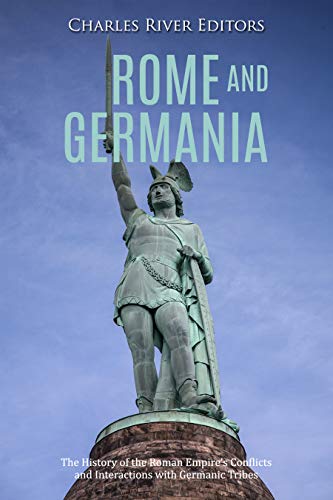Rome and Germania: The History of the Roman Empire’s Conflicts and Interactions with Germanic Tribes
*Includes pictures*Includes excerpts of ancient accounts*Includes a bibliography for further reading*Includes a table of contents Despite all the accomplishments and widespread victories and conquests throughout the long history of Republican and Imperial Rome, general perception still deems the Romans to have failed in one crucial conquest: the subjugation of Germany. Indeed, historians have singled out
*Includes pictures
*Includes excerpts of ancient accounts
*Includes a bibliography for further reading
*Includes a table of contents
Despite all the accomplishments and widespread victories and conquests throughout the long history of Republican and Imperial Rome, general perception still deems the Romans to have failed in one crucial conquest: the subjugation of Germany. Indeed, historians have singled out this one failure as central to the ultimate downfall of the entire empire, as the constant wars against the Germanic tribes, and the need to defend the frontier on the Rhine at great expense against those tribes, helped bring the empire to its knees. There are elements of truth in such a conclusion, but the reality was far more fluid than is often realized.
From the 1st century BCE until the collapse of the Western Roman Empire in the 5th century CE, the relationships between the wider empire and those living in what is now modern Germany were extremely complicated, involving much more than simple warfare. In fact, archaeologist Are Kolberg suggested that there were four distinct aspects that must be considered: military, trade, gifts, and plunder. One could also add the political aspect to this, given the impact that German troops came to exert in the elevation of different emperors to the throne at different times.
As a Roman territory, Germania at one point included significant areas of land east of the Rhine, all the way up to the Elbe. The Romans would maintain a significant force on this eastern side until the 3rd century CE, but eventually a Frankish invasion ended that presence, and the term Germania came to refer specifically to the territory west of the Rhine, which included the two provinces of Germania Superior and Germania Inferior, or Upper and Lower Germany. Those provinces were key to the defense of the empire, so much so that Triers provided the location of one of the four seats of government near the end of Rome’s reign.
The people that came to be known as Germans originally came from Scandinavia and were mainly shepherds and hunters, but they comprised a number of distinct groups, the most important of which were the Goths, Vandals, Franks, and Saxons. Within each group, there were separate tribes, and as their populations grew, the land they occupied in Scandinavia was unable to support them, so they began migrating south, settling outside the borders of the Roman Empire. The Germans were fierce warriors who employed rather crude but effective tactics in battle. Their main approach was one of charging directly at an enemy and fighting hand-to-hand using their long swords and shields. Body armor was unknown, and they wore only animal-skins. Most warriors wore their hair long, dyed red and greased into ponytails.
Friction between Rome and the German tribes can be traced back as far as 113 BCE, and the next 500 years brought full-scale campaigns by the Romans against the various individual tribes, resulting in numerous battles and constant uprisings wherever any part of the land east of the Rhine was occupied for any length of time. The impact of this constant warfare on both sides cannot be underestimated, and all the while, the fighting and other interactions had massive cultural and political influences going in both directions.
Rome and Germania: The History of the Roman Empire’s Conflicts and Interactions with Germanic Tribes examines the many battles and events that impacted how Rome co-existed with Germania over several centuries. Along with pictures depicting important people, places, and events, you will learn about Rome and Germania like never before.
Bestsellers 2021
Auto Amazon Links: No products found.







Comments
Comments are disabled for this post.